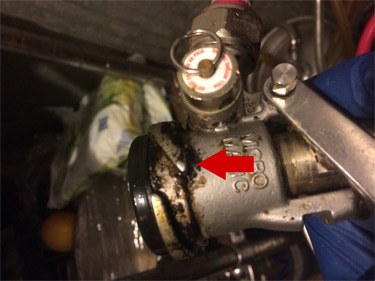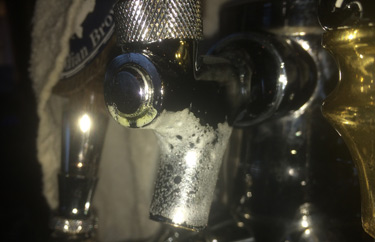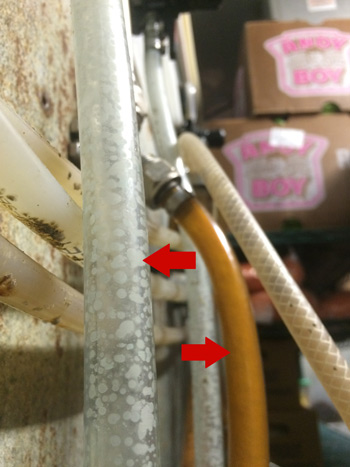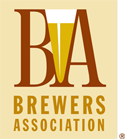Sensory Check Your System for Spoilage: See, Smell, Taste?
Performing sensory checks on your tap system is important for obvious reasons:
- To ensure the health and safety of your guests
- To maintain proper draught beer quality
- To check that your line cleaner is performing up to par.
A draught beer system that is properly maintained on a two week schedule should never fall victim to spoilage issues. But if it has been longer than 2 weeks since your system’s last cleaning, or if you feel that recent cleanings have not been fully effective, you can perform simple sensory checks on your tap system to locate sanitation trouble spots.
How to Check Your System for Spoilage
Keg Couplers and Faucets
 The most common points of microbial infection on a tap system are the faucets and keg couplers. These two locations are constantly exposed to open air where airborne bacteria, mold, and yeast will continually take advantage of beer as a nutrient source, forming films on sugar and protein residues that develop on these components.
The most common points of microbial infection on a tap system are the faucets and keg couplers. These two locations are constantly exposed to open air where airborne bacteria, mold, and yeast will continually take advantage of beer as a nutrient source, forming films on sugar and protein residues that develop on these components.
If a keg coupler is infected with microbial film, it will be very visible. Simply remove the coupler from the keg and inspect for any slimy, moldy buildup around the seal and keg-coupler connection. If a microbial film is present, those microbes are certainly infecting the beer in your tap system as well, and immediate corrective action is required.
Couplers should be removed from kegs and soaked in soapy  water. Most of the film will fall off and the remainder may be scrubbed off using a small brush (toothbrush works well). To prevent future films from growing, couplers may be sprayed regularly with a simple antiseptic solution such as 50/50 rubbing alcohol (isopropanol)/water or 50/50 ammonia/water. These chemicals are strong antimicrobial agents that are safe to use as a no-rinse sanitizer on tap system components and will leave no flavor or aroma in the beer.
water. Most of the film will fall off and the remainder may be scrubbed off using a small brush (toothbrush works well). To prevent future films from growing, couplers may be sprayed regularly with a simple antiseptic solution such as 50/50 rubbing alcohol (isopropanol)/water or 50/50 ammonia/water. These chemicals are strong antimicrobial agents that are safe to use as a no-rinse sanitizer on tap system components and will leave no flavor or aroma in the beer.
Beer faucets are of equal concern as they will spend their entire life exposed to an array of airborne pathogens and spoilage microorganisms. Faucets are made of food grade materials that inhibit the binding and growth of airborne microbes. But a poorly maintained faucet loses its antimicrobial properties when beer and foam is allowed to dry on the exterior. These dry residues are an  open invitation for microbial contamination. Airborne bacteria, mold, and yeast will quickly bind to these residues, metabolize them, and produce off-flavors and aromas at the faucet.
open invitation for microbial contamination. Airborne bacteria, mold, and yeast will quickly bind to these residues, metabolize them, and produce off-flavors and aromas at the faucet.
If there is any visible film on or in a faucet, it should be de-soiled immediately using a clean wet cloth and faucet brush. Faucets must be sanitized at the end of each shift using a simple chemical no-rinse sanitizer such as alcohol, ammonia, or an oxidizer.
To check for faucet sanitation issues, first observe the outside of the faucet for any dry beer residue and mold growth around the lever, plunger, and shank collar. Next check the inside of the faucet by rolling up a white paper napkin, inserting it into the faucet spout, then twisting and removing the napkin to see if any residue is being collected. If there is visible residue on the napkin, your faucets are in need of more frequent in-house sanitation procedures.
Next, sensory check for spoilage by smelling the napkin for a number of aromas that are often present. They are commonly described as having pungent characteristics of stinky feet, cheese, and vinegar. If you detect any of these odors, then common spoilage bacteria and yeast are present which produce acetic, lactic, and butyric acids that we associate with having these classic beer-spoilage aromas. Also, be sure to check faucet covers in the same way you checked your faucets, as these can be a site of infection (and re-infection) if not kept to the same sanitary standard as your faucets. Faucet covers should be soaked in sanitary solution when not in use and cleaned regularly using a faucet brush.
Drip Trays and Drains
Another common spoilage site is the beer drip tray and drain which are located just inches below the faucets. Your efforts to maintain clean beer faucets will be aided if a clean drip tray and drain is maintained. An infected drain will emit intense sour spoilage aromas, as well as provide a secondary site for bacteria, mold, and yeast to breed and produce future generations that will continually re-infect faucets and draught beer lines. Stale odors will be evident and residue buildup is usually visible inside the drain tube if drain cleaning has been neglected. Drip trays and drains should be flushed daily with hot water and can be stored overnight with a thick detergent inside to kill odors and prevent further microbial contamination.
Refrigerators
Proper refrigerator hygiene is of considerable importance to the overall sanitation of a tap system. It is natural for spillage to occur in a walk-in refrigerator or beer box. It seems that every time a keg is changed some small amount of beer seems to seep out and find its way onto the floor. These tiny beer puddles aren’t even noticeable at first, but over time they will build up to create a major sanitation problem. Cold-tolerant bacteria, mold, and yeast breed on these beer residues left in refrigerators. Refrigeration will slow their growth, but it will never stop it completely.
Films of mold on refrigerator floors become especially visible if proper housekeeping procedures are not adhered to. One of the best investments for a keg cooler (other than the kegs themselves) is keg racks that hold kegs about 6 to 12 inches off the ground. This enables easy, continuous clean-up without ever having to move or lift kegs to mop under. By eliminating beer residue buildup inside keg coolers, airborne bacteria, mold, and yeast populations are significantly reduced, thus preventing these microbes from entering the lines.
Vinyl Lines
 If exterior tap system components have experienced spoilage issues, then it’s likely the interior of the system contains spoilage microorganisms as well. Mold on keg couplers quickly makes its way into beer and gas lines. If your system was properly designed with clear vinyl jumper lines, then you will be able to see microbial deposits if infection is present. These deposits will appear as dark discolorations, solid films, and/or spots of microbial colonies.
If exterior tap system components have experienced spoilage issues, then it’s likely the interior of the system contains spoilage microorganisms as well. Mold on keg couplers quickly makes its way into beer and gas lines. If your system was properly designed with clear vinyl jumper lines, then you will be able to see microbial deposits if infection is present. These deposits will appear as dark discolorations, solid films, and/or spots of microbial colonies.
You may also check for spoilage aromas in your gas lines by removing the coupler from the keg, moving the coupler handle into its down position (as if tapping a keg), and allowing for CO2 to flow from the coupler. CO2 has a refreshing aroma like the clean effervescence of mineral water. But if vinyl gas lines are contaminated, the CO2 will smell more like bad breath or a dirty locker room. Be sure to return the coupler handle to its up position to stop CO2 flow after inspection, as CO2 buildup in an enclosed area, like a refrigerator, poses a severe asphyxiation hazard.
Due to the highly porous and absorbent nature of vinyl materials, infections in vinyl lines are very difficult to remove, even with extreme chemical cleaning attempts. Tap systems are designed so that vinyl line replacement is easy and affordable. It is recommended that vinyl lines showing signs of infection be replaced immediately. By  doing so, permanent sources of spoilage are completely removed from the system, providing a clean slate for fresh draught beer service.
doing so, permanent sources of spoilage are completely removed from the system, providing a clean slate for fresh draught beer service.
If your draught beer system is equipped with foam-on-beer detectors (FOBs), this may be another site of infection. These devices are made out of plastic materials that, like vinyl, will absorb residues and off-flavors over time. These devices also create dead spots (points where flow is limited) in the system, which promotes the deposition and growth of microbial films. Check your FOBs for discoloration and film. FOBs must be removed from the system, disassembled, and scrubbed internally in order to achieve proper sanitation.
Observe the Beer
Finally, observe the aroma, flavor, body, and head retention qualities of beer served from your system. The beer itself should be the initial indicator of sanitary quality and the final confirmation of a properly maintained draught beer system.
The most profound analysis is offered in the first glass of beer poured from each line every day. This pint has sat in the line the longest and has had the greatest opportunity to pick up off-flavors and aromas. Pour this beer into a clean glass that is free of any sanitizer residue. Immediately after pouring, draw the aromatics of the first beer in through your nose focusing discretely on the malt and hop aromatic qualities. Both should be intense and uncompromised by any foul odors.
Next, set the glass down and allow the foam to settle. Clean beer served in a clean glass will maintain some head on the surface of the beer and some head will remain adhered to the interior of the glass as well.
Also, look for clarity in the body of the beer. Most filtered beer will allow light to pass through regardless of the color of malt used. A beer served from poorly maintained draught beer lines may be hazy and block light due to suspended solid sediment that is picked up within a dirty beer line. If your beer passes olfactory and visual inspection, then taste it. Bartenders and servers should be encouraged to regularly sample draught beer so that they become intuitively aware of the unique qualities of each beer, and will be able to immediately recognize spoilage issues.
Be sure to have your beer lines cleaned every two weeks, as recommended by the Brewers Association and the State of Ohio, and perform random in-house sensory checks to learn the quality of your system, the quality of the beer it is dispensing, and the quality of workmanship of the beer line cleaner you have hired.
Lastly, perform sensory checks because if you don’t, someone else will. And that person will likely be a customer (or multiple customers) who will either rave to their friends about your beer selection and the quality of service, or insist on never going back because their stout was skunky and sour.




